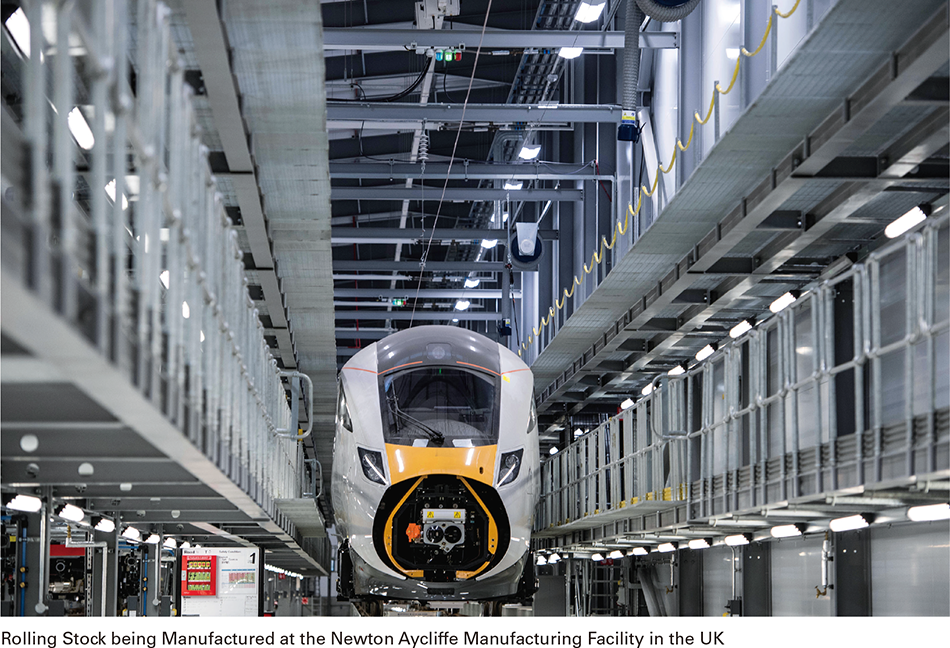COVER STORY:GLOBAL INNOVATION REPORTInnovation to Drive Transport Solutions for AllHitachi’s Effort Using Inclusive Design
Highlight
Passengers are at the heart of the Hitachi railway business across the globe. They are the end users for Hitachi solutions and are therefore an integral focus for all design and innovation activity. Hitachi has a refocused approach on passenger-centric rolling stock design that aims to meet the challenges of an ever-changing population. Designing products that are adaptable to those with diverse usability issues, including accessibility needs across the range of physical and cognitive abilities, is central to Hitachi’s vision for the future. By applying an “inclusive design” approach to its mobility solutions, new value can be added to any product or service that people interact with, whilst delivering benefits to society.

Introduction
Hitachi’s railway business division is a fully integrated, global provider of rail solutions across rolling stock, signalling, operations, service and maintenance, digital technology and turnkey solutions. The global business has a presence in 38 countries across three continents and over 12,000 employees. In the UK, Hitachi has delivered 122 new trains for the Intercity Express Programme (IEP), the largest investment in UK rolling stock in over 30 years. Further projects include an all-electric fleet of commuter trains operating across Scotland, and new bi-mode fleets for multiple operators, which will see over 286 new Hitachi trains in the UK by 2021.
As the business expands to look at new opportunities, the transport industry is also changing; the way rolling stock is procured is developing to consider users with a range of abilities. Passengers now have a larger voice and influence than ever before, due to the rise in social media, change of funding structures for mobility solutions and enhanced understanding of railway infrastructure projects. Diversity and inclusion has been important for businesses internally to display efforts for their own teams and workforces, this is now changing to consider the end user for products – the passengers. There is an understanding that mobility solutions must be fit for purpose for large societal demographics and need to support those with specific usability requirements. Passengers are at the heart of the design process for future opportunities and learning how to integrate these demands within the projects is key to the success of the UK railway business.
The Challenge
In the UK, before the current challenges and changes we are now seeing with COVID-19, passenger transport usage was at an all-time high. In Great Britain, rail usage over the last two decades has almost doubled following decades of decline(1). Over the past 20 years, rail journeys have increased by 97% to reach a record 1.8 billion journeys in FY2018(2), increasing faster than any other mode of transport. This offers wide benefits to society, which include supporting government decarbonisation agendas with rail being low-carbon compared to other modes of transport. It also remains one of the safest forms of transport with 0.3 fatalities per billion passenger miles(3). However, an increase in usage also brings new challenges to manufacturers like Hitachi and to customer operators (see Figure 1 and Figure 2).
Figure 1 | Current Challenges Facing Rail Transport Users with Accessibility Issues
 Disabled passengers use trains for much the same reasons as other passengers: It is quick, convenient and enjoyable. 21% of disabled passengers find train travel difficult. Almost half of all disabled passengers agree with the statement: “I accept difficulties with travel is part of having an impairment.”
Disabled passengers use trains for much the same reasons as other passengers: It is quick, convenient and enjoyable. 21% of disabled passengers find train travel difficult. Almost half of all disabled passengers agree with the statement: “I accept difficulties with travel is part of having an impairment.”
Figure 2 | Percentage of People with Mobility Problems
 The UK population is aging and age brings in increased problems when using public transport, focused on mobility and ease of movement.
The UK population is aging and age brings in increased problems when using public transport, focused on mobility and ease of movement.
Increased passenger numbers means a more diversified customer group, including those with disabilities. Nearly 14 million people in the UK identify as having a disability(4); disability and accessibility needs vary across the population and not all requirements are immediately visible. On a day to day basis there are many practical and emotional barriers to travelling by train. A passenger’s journey can be fraught with potential problems; not only putting their journey into question, but sometimes posing a threat to their health – both mentally and physically. As well as practical issues, the extent to which a passenger experiences barriers to travel often depends on their own and others’ perceptions of their disability – there is a perceived “hierarchy of deservedness,” whereby people with certain disabilities are seen as (and sometimes see themselves as) being less “deserving” of help than others(5). Many operators and railway stations offer accessibility assistance services, which are often very effective when used. However, standards of assistance can vary quite markedly. In addition, many who could use assistance are not aware of what is available. Those who travel alone will also often have different experiences to those travelling in a group or with a partner; in the UK on average 50% of journeys are taken alone by users with accessibility issues. Hitachi realised that in order to support these users, and specifically those travelling alone, a change was needed in how trains are designed from the very beginning.
On-board systems and interiors need to be intuitive and as accessible as possible to the largest group of people. Once arriving at a train platform, over 28 different conscious actions are considered between boarding the train and embarking at the final destination. “Is this the correct train?” “Where is my seat?” “Can I safely store luggage?” “How long will the journey be and when must I prepare to leave the train?” The inclusive design process aims to make these conscious actions as simple as possible – to reduce anxiety, minimise stress, support daily tasks and to deliver solutions that work for everyone, no matter what their requirements might be.
Opportunities for Collaboration
Once Hitachi had identified a need for change, a project began to examine how passenger experience could be quantified to understand the elements of a journey that could be reexamined during design phases. This would be to address new requirements for future bidding activity and to support the evolving users of current fleets in service. A collaboration was formed between Hitachi Rail Limited, Hitachi’s Center for Social Innovation, First Class Partnerships Limited, a British transport consulting company, and the University of Cambridge Engineering Design Centre to start looking at a refocused approach. By understanding the physical, cognitive and sensory capabilities of the British population across all ages and abilities, the Hitachi team can anticipate the greatest needs of future passengers (see Figure 3).
Figure 3 | Inclusive Design for Better Design
 By focusing on inclusive design from the beginning of each project, Hitachi can offer solutions that support the widest group of society.
By focusing on inclusive design from the beginning of each project, Hitachi can offer solutions that support the widest group of society.
Figure 4 | Ford Motor Company’s “Third Age Suit” in Use
 Through co-creation with Ford Motor Company and others, Hitachi used Ford’s “Third Age Suit” (a suit that simulates the experience of the elderly) to allow the team to experience impairments first hand in designing a train that is inclusive of passengers with mobility problems.
Through co-creation with Ford Motor Company and others, Hitachi used Ford’s “Third Age Suit” (a suit that simulates the experience of the elderly) to allow the team to experience impairments first hand in designing a train that is inclusive of passengers with mobility problems.
The project initially started by quantitatively assessing the population and potential exclusion possibilities for a passenger journey on several current classes of train. This provided insight and highlighted a magnitude of issues that passengers with reduced capability may experience. Innovative new tools were used such as impairment simulation gloves (to emulate arthritis and aging hands) and glasses to allow the team to experience visual impairments first hand, facilitating empathy with those passengers. The team soon realised that designing directly from the perspective of empathy will help future projects to drive positive change.
The collaboration with Cambridge University also brought a new research methodology including the use of the Ford “Third Age Suit” loaned to the team by Ford Motor Company in Germany (see Figure 4). Previously used in the design of the award winning Ford Focus the suit provided new insight into how users of cars would approach different tasks and how the car could be made more inclusive, resulting in improved user experience for all. This suit had never been used before in train design and supported the team in experiencing use of the train interior whilst experiencing impairments to hands, arms, torso, legs, vision, and hearing.
Following the initial research project, a greater understanding of how passengers are using Hitachi rolling stock was developed, alongside key design changes and suggestions that reduced the exclusion areas faced by passengers. This has supported conversations with supply chain and additional partners to examine new ways of working both on-board a train, and as part of the wider transport passenger journey – including station wayfinding and passenger information systems. Hitachi is now further developing the project, with plans to increase collaboration with Cambridge University and key partners to build on the current inclusive design toolkit and support future research proposals.
Adding Value to the Hitachi Brand
Inclusive design is an improved way of thinking for many engineers and the work initiated in the UK can now be rolled-out globally, and throughout wider Hitachi group companies, to support all aspects of design activity. For the railway business specifically, this approach will be applied to future rolling stock bidding activity to offer a clear differentiator between Hitachi and competitors. These principles can also be applied to existing fleets – in service, or being delivered. Allowing Hitachi to exceed customer expectations for passenger experience and offering the potential for changes with customer-funded enhancements. This creative direction positions Hitachi’s railway business division as a leader in the rail market, helping it to steer the wider transport industry in putting passengers first.
As Hitachi continue to develop the next generation of employees, the company will provide inclusive design training to grow its design and engineering capability so this new innovative design tactic becomes part of the standard approach to innovation. Inclusive design for Hitachi, is better design.
Conclusions
The population is constantly changing and evolving and Hitachi’s products need to be able to do the same to support every part of society. As it look to deliver rolling stock solutions for the future, Hitachi is investing in new ways of thinking to drive innovation across train design. Mobility products are essential to connect diverse cities and cultures, and by leveraging the power of the company, Hitachi can continue to contribute to society’s needs for decades to come.
REFERENCES
- 1)
- Department for Transport, “Transport Statistics Great Britain” (Dec. 2019)
- 2)
- Office of Rail and Road, “Passenger Rail Usage,”
- 3)
- Department for Transport, “Road Accidents and Safety Statistics” (Feb. 2020)
- 4)
- Department for Work and Pensions, “National Statistics—Family Resources Survey: Financial Year 2016/17” (Mar. 2018)
- 5)
- Transport Focus, “Disabled Rail Passenger Research” (Jul. 2019) (PDF, 3.57MB)





